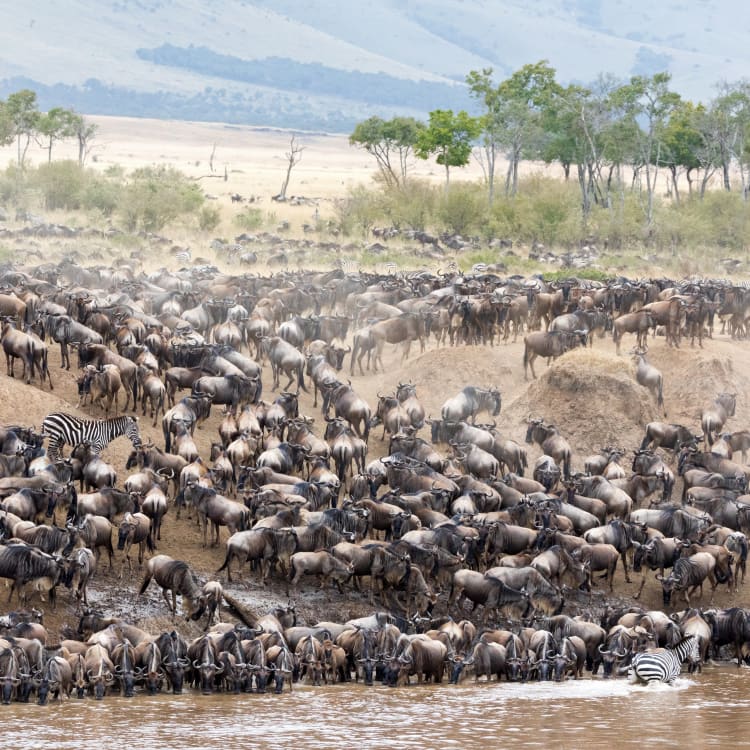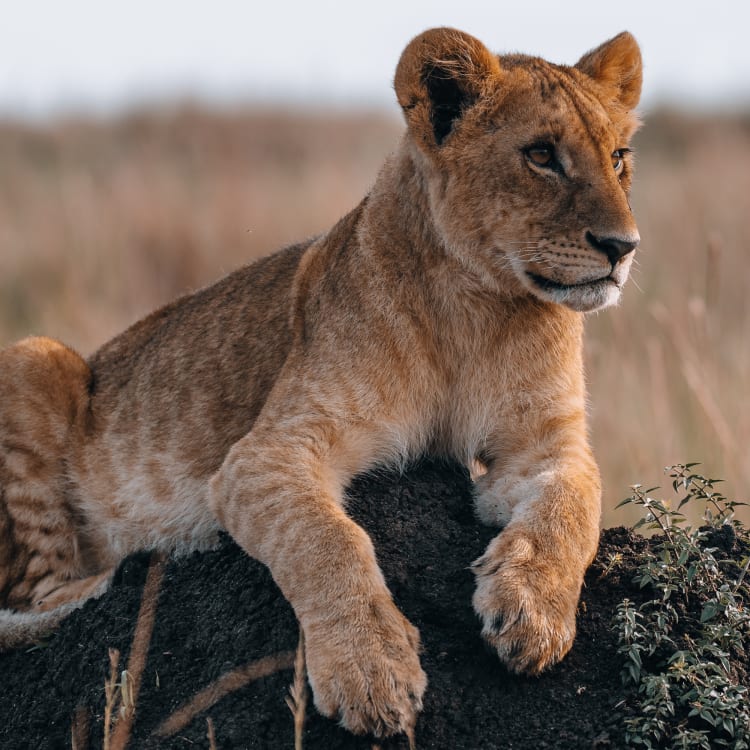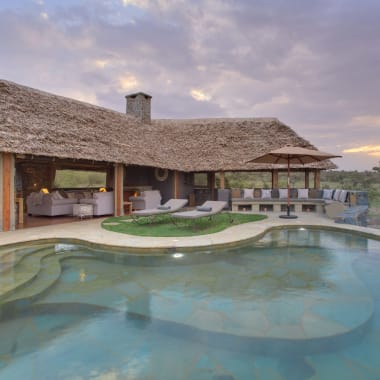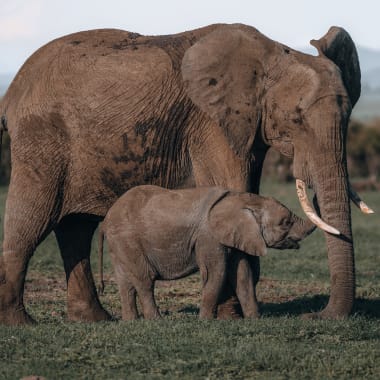
Masai Mara
Why the Masai Mara is one of the world's leading safari destinations
Immerse yourself in the magic of the Masai Mara, the world-famous national park in the heart of the Kenyan wilderness. Covering over 1,510 square kilometers, the Masai Mara offers an impressive variety of landscapes that have always captivated nature lovers - from gentle grassy plains to thorn bush and tree savannas to meandering watercourses. It is home to an equally diverse animal world with the legendary "Big Five" - lions, elephants, buffalo, leopards and rhinos - as well as a wealth of other species. They make this area one of the world's most beautiful safari destinations.
The name "Masai Mara" honors the nomadic Maasai people who have lived here for centuries and whose culture and traditions are deeply rooted in this region. "Mara" means "spotted" in their language - and this is how they describe the small islands of shadows cast by individual clouds as they move across the vast plains. In the Masai Mara, untouched nature and cultural depth merge to create an unforgettable experience that touches the heart and mind in equal measure.
Best time to travel
The best time to visit the Masai Mara is between July and October
The miracle of the Great Migration: a natural spectacle in the Masai Mara
The Masai Mara is the scene of a natural phenomenon of breathtaking beauty and power that is millions of years old and unique in the world - the "Great Migration". It begins in May, when 1.3 million wildebeest, 500,000 Thomson's gazelle, 97,000 topi, 18,000 eland and 200,000 zebra migrate north from the Serengeti, and usually reaches the Masai Mara in early July. The driving force behind this epic journey of the herds is the search for water and new pastures: The Masai Mara is home to large, year-round rivers such as the Mara River, which ensure the survival of the species during the long dry season.
Crossing these often raging rivers is immensely dangerous for the migrating animals. This is not only due to the fast floods of the Mara River and the Nile crocodiles waiting for easy prey. Predators such as lions, hyenas, leopards, cheetahs, jackals and vultures also lurk on the opposite bank of the river to hunt down injured or isolated animals.
Watching the river crossings is an exciting and unforgettable experience. The excitement and emotional connection that visitors feel with the animals during these dramatic moments is indescribable. Overall, the Great Migration in the Masai Mara is a natural spectacle that is second to none and attracts thousands of visitors from all over the world every year. The best way to observe this spectacle is on a safari that takes you into the heart of the Great Migration. Experienced guides will take you to the best vantage points so that you can witness this spectacular event, which is considered one of the seven new wonders of the natural world.
Wildlife and plants in the Masai Mara: a mosaic of biodiversity
The Masai Mara is a true paradise for nature lovers and offers an amazing variety of animal and plant species. In addition to the wildebeest, zebras and gazelles of the Great Migration, the wild animals known as the "Big Nine" also live here. These include the famous Big Five - lion, elephant, rhino, leopard and buffalo - as well as cheetah, giraffe, zebra and hippo.
Each of these animals has its own fascinating charisma. The Cape buffalo, known for their unpredictable nature, are often found in large herds near water sources. Cheetahs, the fastest land animals in the world, thrill with their hunting tactics in the open savannah. The majestic giraffes, the tallest living land animals, are a particularly impressive sight, as are the hippos, which are mainly found in the waterways. However, the Masai Mara is also home to a wealth of other animal species, including various antelopes, aardvarks, aardwolves, African hares, banded mongooses and bat-eared foxes. The reserve is also the best place in Africa for birdwatchers - with over 470 bird species identified, from large birds of prey and raptors to colorful songbirds.
The landscape of the Masai Mara is no less diverse. Characterized by golden grasslands, riverine forests and the impressive Olooloo Escarpment - a rock face that stands in dramatic contrast to the otherwise flat and open savannah landscape - it contributes to the diversity of wildlife. The open, vast grasslands provide ideal conditions for dramatic predator-prey hunts. The riverine forests along the Mara River, surprisingly green and lush, provide shelter and food for a variety of insects, birds and animals, contributing to the biodiversity of the Masai Mara. It is this biodiversity that makes the area such a valuable ecosystem and therefore one of the most sought-after safari destinations in the world.
Cultural encounters in the Masai Mara: insights into the life of the Maasai
A visit to the Masai Mara offers a unique opportunity to experience the fascinating culture of the Maasai - a tribe of brave warriors, skilled trackers and semi-nomadic cattle herders. The Masai, who have lived in harmony with the wildlife for centuries, are known for their bright red robes, their deep connection with nature and their centuries-old traditions.
When you visit an authentic Maasai village and its inhabitants, you will notice the vibrant colors of their clothing and the rich jewelry of the women that expresses their identity and social status. The warm welcome with singing and dancing, including the famous "jump dance", is an unforgettable experience. Guests are often even invited to join the dancers. The traditional Maasai villages consist of small huts built from mud, cow dung and straw by the women of the village. They offer a deep insight into the humble but rich everyday life of the Maasai, who are known for their sustainable way of life. In addition to bartering, they support each other with the things they need without expecting anything in return. In this way, they ensure that all members of the group survive.
The Maasai have managed to preserve many of their traditions and lifestyle almost unchanged, while living in harmony with the modern world. By choosing to tour a Maasai village or cultural center, you will not only learn about a different culture, but also make a positive contribution to supporting the local community, preserving cultural heritage and sustainable tourism.
Private Mara Conservancies
The Masai communities play an important role in conservation and sustainable development efforts in the Masai Mara: they manage the "Mara Conservancies", a network of protected wildlife areas. These conservancies are a crucial part of the Masai Mara ecosystem and serve as important corridors for animal migration. By visiting the conservancies, guests not only contribute to the preservation of the unique wildlife, but also support the local Maasai communities in their efforts to protect nature and promote sustainable development.
Faced with increasing threats from overpopulation, land use conflicts and poaching, the Maasai and conservationists saw the need to find new ways of protecting and sustainably using the Mara ecosystems. The establishment of these conservancies has created a balance between conservation, wildlife preservation and economic development for the Maasai communities, while providing visitors with a unique experience.
Naboisho Conservancy
The Naboisho Conservancy covers over 52,000 hectares and is managed by a community of 636 landowners. A large number of lions live here - it is one of their largest territories worldwide. In addition to elephants, giraffes and wildebeest, the Naboisho Conservancy is also home to rare species such as aardvarks, caracals, serval cats and aardwolves. It is also a paradise for birdwatchers, as it is home to rare species that are otherwise rarely seen in the Masai Mara. The conservancy model in Naboisho focuses on regulating the number of visitors to minimize the impact on the environment and wildlife while supporting the local communities.

Mara North Conservancy
The Mara North Conservancy (MNC) is located in the northwest of the Masai Mara ecosystem. The MNC was founded in 2009 as a non-profit organization to support conservation efforts in the Masai Mara. It is home to abundant wildlife, including the Big Five, and is particularly known for its high lion populations. With a strong focus on sustainable tourism, MNC offers an intimate safari experience. MNC is strongly committed to community initiatives and is actively involved in the conservation of Africa's biodiversity.

Olare Motorogi Conservancy
The Olare Motorogi Conservancy is characterized by its strong partnership with the Maasai community, which provides land for conservation. This approach has contributed significantly to the protection of wildlife diversity while providing economic benefits to the Maasai. The combination of first-class wildlife viewing and luxurious accommodation is unique. Here you can experience nature intensively without having to compromise on comfort. The Olare Motorogi Conservancy is therefore an outstanding example of a successful combination of nature conservation and sustainable luxury tourism.

Activities in the Masai Mara
You can experience the breathtaking wilderness and fascinating wildlife of the Masai Mara from very different perspectives and with many different activities. From classic game drives to hot air balloon safaris and hikes on the tracks of wild animals - the Masai Mara offers the right experience for every adventurer and nature lover.

Game drives
Discover the breathtaking diversity of the Masai Mara on a game drive. Observe the majestic Big Five, abundant birdlife and rare species such as cheetahs and hyenas in their natural habitat. The open plains offer perfect conditions to see these fascinating creatures in action, especially during the dry season when the animals come to waterholes and rivers.

Hot air balloon safaris
A hot air balloon ride at dawn offers a new view of the Masai Mara. Glide in silence over the vast savannahs, observe the wildlife from the air and experience the spectacular natural spectacle of the Great Migration from a unique perspective. This tranquil drive lets you experience the Mara in all its splendor and gives you unforgettable photo moments.

Nature hikes
On guided hikes, you can discover the smaller flora and fauna of the Masai Mara, which is often overlooked on game drives. Accompanied by experienced guides, you will learn more about the ecosystems, traditional Maasai medicine and the tracks of the wild animals. These walks allow you to immerse yourself deeply in nature and experience the silence and beauty of the wilderness up close.
Masai Mara: Best time to travel, arrival and follow-up activities
The best time to visit the Masai Mara is from the end of June to the beginning of October. This is when the great animal migration takes place. These months also offer the most favorable conditions for game viewing as the vegetation is less dense. However, it is also the busiest and most expensive time, so it is advisable to travel either at the beginning or end of this period. The rainy months from March to May and November and December can be more difficult for safari, but offer better deals. For a less crowded but still impressive experience, December could be a good choice - the rain showers are much shorter during this period than between March and May. Daytime temperatures range from 24 degrees in June/July to 28 degrees in December.
To get to the Masai Mara, most visitors first fly to Nairobi, Kenya's capital and main transportation hub. From there, they take a short domestic flight from Wilson Airport to one of the many airstrips in the Masai Mara. These flights not only save time, but also offer fascinating views of the landscape. Alternatively, it is also possible to travel by road. The drive from Nairobi to the Masai Mara takes between four and five hours.
After the adventure of a safari in the Masai Mara, you can relax wonderfully on Kenya's picturesque coasts. The white sandy beaches of Diani or the historic island of Lamu are perfect for long walks on the beach, surrounded by the gentle sound of the sea and a warm breeze. Or discover other natural wonders of Kenya, such as Amboseli National Park, where you can watch elephants against the majestic backdrop of Mount Kilimanjaro. A visit to Nairobi, the lively capital, with its cultural treasures and historical sites, makes your unforgettable trip to Kenya perfect.
Travelling Masai Mara
Our camp in the Masai Mara was really great. The tents at Naboisho Camp were all newly made and beautifully furnished. It was a great surprise and even better than in the pictures. The conservancy is great and it was a great tip from you not to sleep in the Mara Reserve. We would recommend it to anyone!
Lodges in the Masai Mara
To book a trip or for more information, contact us. We'll help you plan and guide you through your upcoming adventure!







